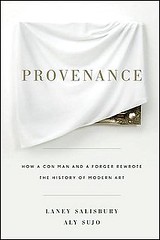
PREV ARTICLE
NEXT ARTICLE
FULL ISSUE
PREV FULL ISSUE
NEW BOOK: PROVENANCE: HOW A CON MAN AND A FORGER REWROTE HISTORY OF ART In a related vein, a new non-numismatic book tells an interesting cautionary tale of how thoroughly talented and enterprising fakers can fool an entire community of experts, along the way inventing new collectibles together with an invented documentary history to back them up. This review appeared in last Sunday's Washington Post - here are some excerpts. -Editor  There's another sentiment that can sneak up on you. I was reminded of it while reading Laney Salisbury and Aly Sujo's well-crafted tale of British con artist John Drewe. I'd expected to despise the psychopath at the center of what Scotland Yard called the biggest art fraud of the 20th century. But somehow, from the first page, he got me to drop my guard. Drewe, for all his odious ambitions, is ingenious, persuasive, even brilliant. As I was pulled deeper into his deceptions, I couldn't help admiring this creep. There's another sentiment that can sneak up on you. I was reminded of it while reading Laney Salisbury and Aly Sujo's well-crafted tale of British con artist John Drewe. I'd expected to despise the psychopath at the center of what Scotland Yard called the biggest art fraud of the 20th century. But somehow, from the first page, he got me to drop my guard. Drewe, for all his odious ambitions, is ingenious, persuasive, even brilliant. As I was pulled deeper into his deceptions, I couldn't help admiring this creep.In "Provenance," Salisbury and Sujo untangle Drewe's elaborate scheme that put more than 200 counterfeit works on the market between 1986 and 1995. What's fascinating about his story is his inventiveness in faking the paintings' provenances. Drewe ginned up receipts for prior purchases; he created catalogs for exhibitions that never took place; he even fabricated records for restoration work that the supposedly decades-old paintings had required over the years. In a master stroke, he smooth-talked his way into the archives of the Tate Gallery, where he inserted some of his phony documents into the files. Experts rummaging about in the archives to certify a work's authenticity would find much to lead them astray. Drewe could have accomplished none of this without a skilled forger. He found the perfect dupe in John Myatt, a down-on-his-luck artist living alone with his two small kids in a rundown farmhouse in England. For at least £150 each, Myatt was turning out "genuine fakes" -- reproductions clearly sold as such -- of works by Monet, Turner and Matisse. His world changed when Dr. John Drewe phoned him. In an upper-class accent, Drewe told Myatt he was a lecturer in nuclear physics and a consultant to the ministry of defense. He would also claim to others to be a descendant of the earl of York, a historian of the Nazi era, an army lieutenant, a weapons expert and a hang glider. None of it was true. Yet blessed with a prodigious memory, Drewe was able to pose convincingly. For nearly a decade, the pair faked work by artists such as Alberto Giacometti, Ben Nicholson, Georges Braque and Nicolas de StaŽl. The fraud was perpetuated by eager salesmen, greedy -- or misguided -- dealers, inattentive auction houses, unwitting art lovers and gullible archivists. It finally unraveled thanks in part to the keen eye and persistence of Mary Lisa Palmer, director of the Giacometti Association. Scotland Yard detectives went to work and brought Drewe and Myatt to trial. In court, Drewe sat impeccably dressed, popping chocolate bonbons into his mouth. To read the complete article, see: A Connoisseur Who Conned the Art World (http://www.washingtonpost.com/wp-dyn /content/article/2009/07/24/AR2009072401421.html) Wayne Homren, Editor The Numismatic Bibliomania Society is a non-profit organization promoting numismatic literature. See our web site at coinbooks.org. To submit items for publication in The E-Sylum, write to the Editor at this address: whomren@gmail.com To subscribe go to: https://my.binhost.com/lists/listinfo/esylum All Rights Reserved. NBS Home Page Contact the NBS webmaster 
|